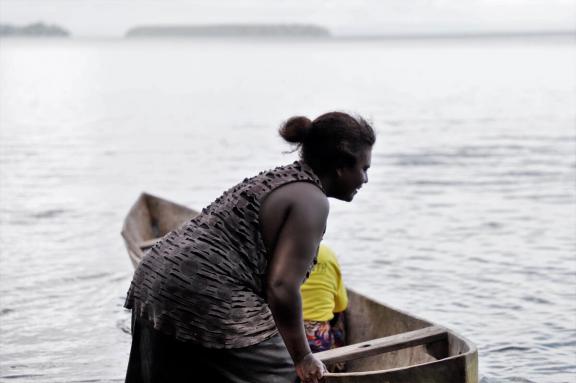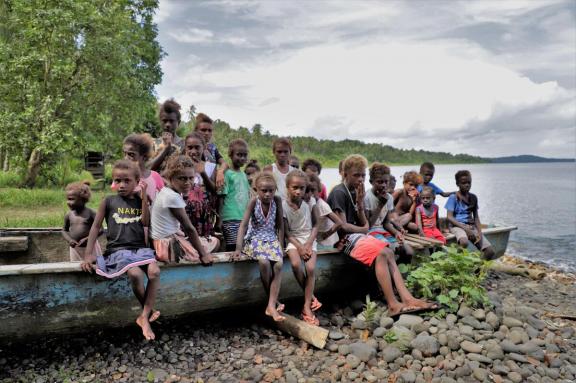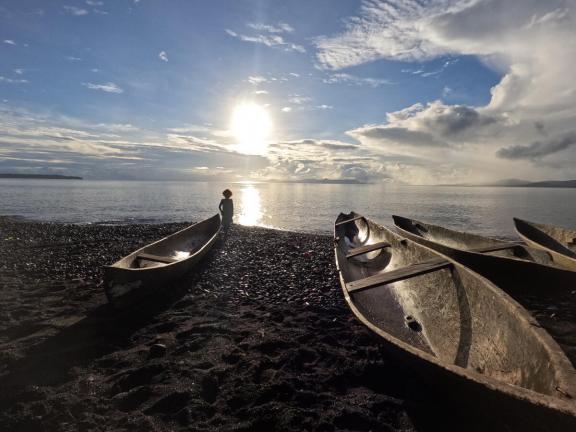The water is rising in the Pacific - and so are community voices.
Mary, a passionate mother of five, lives in a remote village in the Solomon Islands. She knows the devastating effects of climate change have already arrived on her island, and she’s driven to have her voice heard.
The Green Climate Fund (GCF) is working in partnership with Save the Children Australia (SCA) who works closely on the ground with communities across the Pacific to help them act against climate change. We asked Mary how climate change is impacting her life.
Mary uses her traditional dugout canoe to catch fish for her children to eat, but the produce she grows in her garden is essential to her family’s food security. She describes how an increase in rain is ruining her crops.

Mary struggles to grow food for her children to eat due to the impacts of climate change on her small village in the Solomon Islands. Photo: Collin Leafasia/Save the Children
“The irregular weather pattern has caused a reduction in food crop harvest in my garden. The vegetables grow well when we plant them, but then insects and rain damage the crops before harvest.”
Mary has also noticed changes to the beach skirting her village. “Now the sea level is very high too. Our sea shore has eroded. Where we used to have our boat sheds and canoe house is now covered by the sea.”
Mary says even her children feel the effects of climate change, and it’s impacting their ability to learn.
“My children and the other children in the village walk to the next village to attend primary school. They must cross two rivers to get to school. When it rains, they don’t go to school because the rivers are flooded and make it impossible to cross.”

An increase in rain is making it difficult for the children from Mary’s village to attend school. Photo: Collin Leafasia/Save the Children
Capturing community voices
Save the Children Australia (SCA) has spoken to over 5,000 Solomon Islanders like Mary to better understand local perspectives on the changing climate. Over three weeks, their local team travelled to 66 villages to ask people how they’re coping with the changes that can no longer be avoided, and what help is needed to safeguard their futures.
With financing from GCF and cofinancing from the governments of Australian, New Zealand and the Solomon Islands, Save the Children is using lessons learned to design a project that strengthens community resilience to climate change in the Solomon Islands. It will be built on these firsthand accounts from community members living on the frontline of the climate crisis.
But SCA isn’t stopping in the Solomon Islands. A year and a half ago, they travelled to the furthest reaches of Vanuatu to listen to community members. Located in the Pacific Ring of Fire, Vanuatu faces frequent earthquakes and volcanic eruptions and is highly vulnerable to the impacts of climate change.

SCA data collector travelling to Sasavele village in the Solomon Islands to hear community perspectives on climate change. Photo: Collin Leafasia/Save the Children
SCA met Chief Tavet Varao, who knew exactly how his remote village in Vanuatu was being impacted.
“Effects from climate change that impact our communities include stronger hurricanes and periods of drought. Sometimes we have strong rains and flash floods, which can destroy our gardens.”
Launching the Pacific’s largest community-based climate project
As a result of the research, SCA launched the largest community-based climate resilience project the Pacific has ever seen. The project, which is financed by GCF and the governments of Australia and Vanuatu, will be implemented in Vanuatu by local government and community organisations with support from SCA. The project will directly reach over 90,000 women, men, young people, and children in all six provinces of Vanuatu directly helping community members to address the impacts of climate change already on their doorstep – and those still to come.
Critically, the project will reach nearly half of the country’s rural population, helping them restore and protect their natural environment and learn climate resilient agriculture and fishing techniques. Women are a critical target of the project, empowering them to establish small eco-businesses, preserving and selling the surplus produce from their gardens to help combat food and income insecurity.

The Vanuatu Community-based Climate Resilience Project will help community members build food security, protect their natural environment, and safeguard their children’s future. Photo: Collin Leafasia/Save the Children
Community voices drive change
The Green Climate Fund and Save the Children are working closely with communities in the Pacific and around the world to help them adapt to climate change and protect their children, who will be burdened by the most dangerous impacts of the climate crisis.
We thank thousands of people like Mary and Chief Tavet for raising their voices. Their stories and recommendations will help improve food security for families, protect natural environments and keep Pacific children safe, today and tomorrow.
Story, images, and video by Save the Children Australia
Edited by Zeenia Dastur, GCF